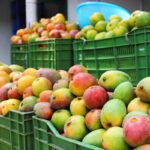"Bizarre" Mexican mango season pushes on

Small sizes look likely to continue for a Mexican mango deal that's been in short supply, but one importer is seeing some of the sweetest fruit witnessed in a long time.
Crespo Organic Mangoes sales and marketing representative Nissa Pierson tells www.freshfruitportal.com there have been a lot of challenges in what has been a "bizarre season".
"There are a number of things happening at one time here – you’ve got the El Niño factor which came in and started the crop early because of the lack of rains and warm weather, which is why we had really early mangoes down in Chiapas in January which is not totally normal," Pierson says.
"The lack of rain that El Niño brought makes fruit smaller so we have a lot of small fruit which the market doesn’t always enjoy.
"And then storms finally came in and knocked off blossoms so you have this shortage of volume, and this abundance of what’s left which is pretty much smaller fruit," she says.
United States Department of Agriculture (USDA) Agricultural Marketing Service (AMS) statistics show prices were up significantly for mangoes passing through Texas and Nogales, Arizona between weeks 7-15.
The average price for a box of Haden mangoes shot up 82% year-on-year to reach US$9.55, while prices were also higher for Ataulfos (+22%, US$7.48) and Tommy Atkins (+47%, US$8.70).
"Prices are at an all-time high, which is making the existing fruit difficult to sell and riskier. Now, that being said there were some early storms that went through Michoacan and Sinaloa and there was a lot of confusion about whether the yields were going to be record-breaking as they predicted at the onset of the season.
"They couldn’t really tell for two weeks because a mango tree aborts 98% of its bloom so you have to wait and see which ones turn into fruit.
"But it turns out they’re predicted to have good yields so that kind of lay the market to rest assuring they’d have good peak season volumes."
She says her company is about to start the season for mangoes grown in Nayarit, which is so far looking "nice" with very clean fruit.
"Everyone's very excited to get into that season; it’ll probably take a while for the entire pipeline to fill, especially with the appropriate sizes, but once we get into the Nayarit season I think things look pretty good for the remainder of the season, buffering any problems that typically come up in the world of produce.
"We don’t know exactly when Sinaloa will peak but we expect it to probably be in June, and a little bit of July as well."
Vision Import Group vice president of sales Ronnie Cohen says agrees the season has been a challenge with unprecedented challenges, highlighting the El Niño issue has caused problems starting with the Ecuadorian deal.
"It started out in Ecuador and then to Peru because Peru ended early, and then Guatemala was delayed and Mexico was delayed," Cohen says.
"For Mexico specifically it’s been mostly Ataulfos and red mangoes that have been on the short side, and there’s been a lot of smaller fruit and not a lot of large fruit.
"The red mangoes have mostly been coming out of Michoacan – there was a bit out of Oaxaca but then they had to stop; they got affected the most. They're looking to be at least 40% down on the historical average."
He says prices have been coming down however because as with any product, certain price points become "unsustainable".
"For each retailer, each marketer and user of product, it’s a different challenge," he says.
"A lot of retailers get it, they’re okay with it and made the proper adjustments, but some of them look at last year’s sales and they all want it at a certain time, but there was a reality that we couldn’t achieve that.
"So in order to do that you had to explain to them what the scenario was and what we thought the way to handle it was."
In Cohen's case, this meant making investments with grower suppliers to ensure they could still get a reasonable price at a level that would still suit retailers.
"I think the biggest challenge is really the fresh cut industry – they’re having the biggest challenge for sure because a lot of the machines they use for fresh cut will only fit certain sizes of mangoes of nines and larger – when you start getting 10s to 14s, then they have to go by hand and that’s more labor.
"When you have a higher price then you have a double whammy, and that’s definitely compromised some of those guys."
He emphasizes fruit sizing is still predominantly small, and the situation is not going to change for those who want larger fruit.
"In the red mangoes it’s Michoacan and Oaxaca for the most part – there’s a little bit coming out of Guerrero, that’s my understanding.
"Ataulfos are coming out of Oaxaca, Michoacan and Chiapas, a little bit out of Guerrero, and we’re not going to see any more volumes come yet until the second week of May and I think we’ll have good promotional volume going forward after that."
While sizes may not be perfect, Pierson says fruit quality has been excellent.
"Even in the Ataulfos the level of Brix is really off the charts this year. They’re some of the sweetest Ataulfos we’ve seen in a long time; again, we’re yet to see the Nayarit fruit so it’s hard to say exactly what those will be like but as far as everybody can predict it’s been the cleanest, most beautiful fruit.
"The Tommy Atkins that we’re at right now in Oaxaca are ripening beautifully, they have good shelf life, so all of this points to a really good season here on out."
Size matters
Pierson says the organic market is perhaps even tougher when it comes to sizing flexibility, but the lower size profile of this year's crop has helped open up new opportunities.
"Especially in the organic market they’re not used to taking whatever you have - an 18 count is an 18 count and a lot of people do not like to change sizing SKUs (stock keeping unit)," she says.
"I believe the consumer isn’t so picky about the counts, but we understand the profitability when you change counts, the difficulty of it, so as we move through these dips and valleys, once a SKU gets into the system it’s a bit easier to incorporate that size into the existing retail structure.
" So there is an opportunity for that because we have been able to move smaller sizes to people who normally would not have taken them...there's been great pricing on the off-size fruit."
Photo: www.shutterstock.com









































